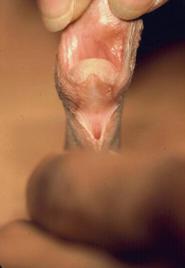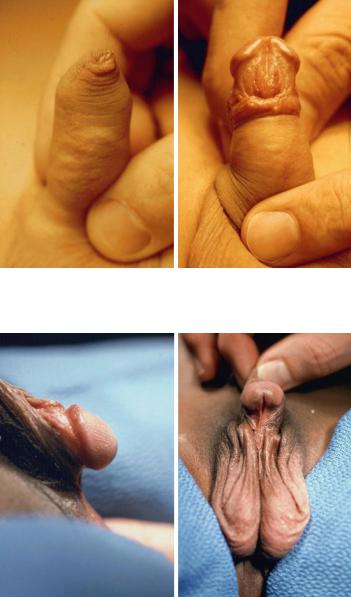
- •Guide to Pediatric Urology and Surgery in Clinical Practice
- •Preface
- •Contributors
- •Key Points
- •1.1 Introduction
- •1.2 Risk Factors
- •1.3 Presentation
- •1.4 Diagnosis
- •1.5 Common Pathogens
- •1.6 Treatment
- •1.7 Imaging
- •1.8 Indications for Referral
- •Suggested Reading
- •Key Points
- •2.1 Introduction
- •2.2 Pathogenesis
- •2.3 Establishing the Diagnosis
- •2.4 Acute Management
- •2.5 Once the Diagnosis Is Established
- •2.6 Long Term Management
- •References
- •Key Points
- •3.1 Introduction
- •3.2 Aetiology
- •3.3 Pathogenesis and Risk Factors
- •3.4 Classification
- •3.5 Signs and Symptoms
- •3.6 Diagnosis
- •3.7 Imaging Studies
- •3.8 Ultrasound Scan (USG)
- •3.9 Voiding Cystourethrography (VCUG)
- •3.10 Dimercapto-Succinic Acid Scan (DMSA)
- •3.11 Treatment
- •3.12 Prophylaxis and Prevention
- •References
- •Key Points
- •4.1 Epidemiology
- •4.2 Presentation
- •4.3 Diagnosis and Workup
- •4.4 Management
- •4.5 Investigations after First UTI in a Child
- •4.6 Prevention of UTIs
- •4.7 Managing VUR and UTIs
- •References
- •Key Points
- •5.1 Introduction
- •5.2 Common Abnormalities of the Scrotum
- •5.4 Indications for Referral
- •Suggested Readings
- •Key Points
- •6.1 Introduction
- •6.2 Common Foreskin Conditions
- •6.3 Treatment of Conditions of the Foreskin
- •6.4 Indications for Referral
- •References
- •Key Points
- •7.1 Hypospadias
- •7.1.1 Introduction
- •7.1.2 Management Issues
- •7.1.3 Indications and Timing of Referral
- •7.1.4 Complications of Surgery
- •7.2 Epispadias
- •Key Points
- •7.2.1 Introduction
- •7.2.2 Management Issues
- •7.2.3 Surgery, Common complications, and Postoperative Issues
- •7.3 Concealed Penis
- •7.3.1 Introduction
- •7.3.2 Referral and Treatment
- •7.3.3 Complications
- •7.3.4 Benign Urethral Lesions in Boys
- •7.3.5 Treatment
- •7.3.6 Follow-Up After Treatment
- •Key Points
- •References
- •Key Points
- •8.1 Introduction
- •8.2 Common Conditions
- •8.3 Treatment of Undescended Testis
- •8.4 Indications for Referral
- •References
- •Key Points
- •9.1 Natural History of the Prepuce
- •9.2 Benefits of Circumcision
- •9.3 Absolute Indications for Circumcision
- •9.4 Relative Indications for Circumcision
- •9.5 Surgical Options
- •9.6 Contraindications to Circumcision
- •9.7 Complications of Circumcision
- •9.8 Conclusion
- •References
- •Key Points
- •10.1 Introduction
- •10.2 Labial Adhesions
- •10.3 Interlabial Masses
- •10.4 Paraurethral (Skene’s Duct) Cyst
- •10.5 Imperforate Hymen with Hydrocolpos
- •10.6 Prolapsed Ectopic Ureterocele
- •10.7 Urethral Prolapse
- •10.8 Urethral Polyp
- •10.10 Vaginal Discharge and Vaginal Bleeding
- •References
- •Key Points
- •11.1 Introduction
- •11.2 Functional LUTS
- •11.2.1 Overactive Bladder
- •11.2.2 Dysfunctional Voiding
- •11.2.3 Underactive Bladder
- •11.2.4 Uroflowmetry
- •11.2.5 Treatment
- •11.2.5.1 Standard Outpatient Urotherapy
- •11.2.5.2 The Failed Training
- •11.2.6 Giggle Incontinence, Incontinentia Risoria
- •References
- •Key Points
- •12.1 Introduction
- •12.1.1 Definition
- •12.1.2 Prevalence
- •12.1.3 Causes
- •12.1.4 Monosymptomatic Enuresis
- •12.1.4.1 Genetics
- •12.1.4.2 Sleep
- •12.1.4.3 Sleep-Disordered Breathing
- •12.1.4.4 Small Functional Bladder Capacity
- •12.1.4.5 Psychological/Behavioral
- •12.1.5 Nonmonosymptomatic (Organic) Enuresis
- •12.1.5.2 Polyuria
- •12.1.5.3 ADH Secretion
- •12.1.5.4 Food Sensitivity
- •12.2 Investigations
- •12.2.1 History
- •12.2.2 Physical Examination
- •12.2.3 Laboratory Tests
- •12.2.4 Imaging Studies
- •12.2.5 Evaluation of Functional Capacity
- •12.3 Conventional Treatment
- •12.3.1 Behavioral Therapy
- •12.3.2 Alarm Therapy
- •12.3.3 Pharmacologic Therapy
- •12.4 Alternative Treatment
- •12.5 Conclusion
- •12.5.1 Areas of Uncertainty
- •12.5.2 Guidelines
- •References
- •Key Points
- •13.1 Introduction
- •13.2 Definition of Constipation
- •13.3 Evaluation
- •13.4 Treatment of Constipation
- •13.5 Indications for Referral
- •Suggested Readings
- •Key Points
- •14.1 Hematuria
- •14.1.1 Important Points in the History
- •14.1.2 Causes of Hematuria
- •14.1.3 Investigations
- •14.1.4 Management
- •14.2 Proteinuria
- •14.2.1 Quantification of Proteinuria
- •14.2.2 Causes of Proteinuria
- •14.2.2.1 Non-Pathological Proteinuria
- •14.2.2.2 Orthostatic Proteinuria (Postural Proteinuria)
- •14.2.2.3 Pathological Proteinuria
- •14.2.3 Investigations
- •References
- •Key Points
- •15.1 Introduction
- •15.2 Indications for Referral
- •References
- •Key Points
- •16.1 Introduction
- •16.2 Treatment of Angular Dermoid
- •16.3 Indications for Referral
- •16.4.1 Introduction
- •Suggested Reading
- •Key Points
- •17.1 Introduction
- •17.2.1 Thryoglossal Duct Cyst
- •17.2.2 Midline Dermoid Cyst
- •17.2.3 Lymph Nodes
- •17.2.4 Thyroid Nodule
- •17.2.5 “Plunging” Ranula
- •17.2.6 Investigations
- •17.3 Treatment
- •17.3.1 Thryoglossal Duct Cyst
- •17.3.2 Midline Dermoid Cyst
- •17.3.3 Lymph Nodes
- •17.3.4 Plunging Ranula
- •Key Points
- •18.1 Introduction
- •18.2.1 Lymph Nodes
- •18.2.1.1 Infective
- •18.2.1.2 Inflammatory
- •18.2.1.3 Neoplastic
- •18.2.2.1 Investigations
- •Key Points
- •19.1 Introduction
- •19.2 Etiology and Types of Torticollis
- •19.3 Treatment of Torticollis
- •19.4 Indications for Referral
- •Suggested Readings
- •Key Points
- •20.1 Introduction
- •20.2 Common Umbilical Conditions
- •20.4 Indications for Referral
- •20.5 Epigastric Hernia
- •20.5.1 Introduction
- •References
- •Key Points
- •21.1 Introduction
- •21.2 Common Sources of Abdominal Pain
- •21.2.1 Children
- •21.2.2 Infants
- •21.3 Treatment of Conditions
- •21.4 Indications for Surgical Referral in Children with Abdominal Pain
- •References
- •Key Points
- •22.1 Introduction
- •22.2 History
- •22.3 Physical Examination
- •22.4 Laboratory Tests
- •22.5 Diagnostic Imaging
- •Suggested Readings
- •Key Points
- •23.1 Introduction
- •23.2 Investigations
- •23.3 Treatment
- •References
- •Key Points
- •24.1 General Principles
- •24.2 Neonates and Newborn
- •24.3 Infants and Young Toddlers
- •24.4 Older Children
- •24.5 Conclusion
- •References
- •Key Points
- •25.1 Introduction
- •25.3 Neonatal Intestinal Obstruction (Distal)
- •25.4 Childhood Intestinal Obstruction
- •References
- •26.1 Introduction
- •26.3 Initial Management
- •26.4 Causes of Neonatal Bilious Vomiting
- •Key Points
- •26.6 Necrotizing Enterocolitis
- •26.7 Duodenal Atresia
- •26.8 Small Bowel Atresia
- •26.9 Meconium Ileus
- •26.10 Hirschsprung’s Disease
- •26.11 Anorectal Malformations
- •26.12 Conclusion
- •References
- •Key Points
- •27.1 Introduction
- •27.2 Presentation
- •27.3 Investigations
- •27.4 Management
- •References
- •Key Points
- •28.1 Introduction
- •28.2 Presentation
- •28.3 Investigations
- •28.4 Management
- •28.5 Surgical Management
- •References
- •Key Points
- •29.1 Introduction
- •29.2 Types of Vascular Anomalies
- •29.3 Investigation of Vascular Anomalies
- •29.4 Treatment of Vascular Anomalies
- •29.5 Indications for Referral
- •Suggested Readings
- •Index

62M.R. Zaontz
››Not all cases of hypospadias require surgical correction particularly those contained well within the glans in the absence of penile curvature.
››Boys with associated penile curvature, misdirected downward urinary stream and or abnormal positioning of the scrotum with respect to the penis require surgical correction.
››Timing for surgery is usually performed around
6 months of age as a single stage outpatient procedure in the majority of cases although, more severe cases may need to be completed in two stages.
››The most common complications of surgery include urethrocutaneous fistula, urethral/meatal stenosis and recurrent penile curvature, all of which are correctable surgically.
7.1 Hypospadias
7.1.1 Introduction
Hypospadias (Fig. 7.1) is one of the more common conditions treated by pediatric urologists. Its incidence is around 8–16/1,000 live births.1 The penis is fully developed within the first 12–16 weeks of embryonic life so there is no associated increased risk of having hypospadias in premature neonates. This entity is usually referred after recognizing the defect at birth. The examiner will note in 95% of the cases that boys with hypospadias will have an incomplete hooded foreskin that is mostly dorsally located and that the opening of the penis is somewhere beneath the normal orthotopic location at the tip of the glans. The opening can be anywhere from 1 mm below the glanular tip to the level of the perineum in the most severe cases. The majority of hypospadias defects are distal in about 70% of the cases.

Chapter 7. Disorders of Male External Genitalia |
63 |
FIGURE 7.1. Example of classic distal hypospadias.
Practitioners need to beware of the boys born with a normal prepuce and have hidden beneath the foreskin hypospadias (Fig. 7.2a and b).This is noted in about 5% of hypospadias boys. Thus, it is imperative that all boys undergoing circumcision have their foreskins fully retracted before cutting, to determine where the urethral meatus is located, and if abnormal avoid circumcision.4
Penile curvature (Fig. 7.3), which commonly accompanies hypospadias, may or may not be appreciated at birth. Without seeing an erection, this is a difficult assessment especially in the boys with mild hypospadias. Curvature and/or ventral tethering of the penis is often more obvious visually in the boy with more proximal meatal locations.
On occasion the examiner may note an incomplete foreskin that has an orthotopic meatus. This boy has the hypospadias complex without hypospadias and, may or may not have penile curvature. Circumcision should be avoided in these boys.

64 M.R. Zaontz
a |
b |
FIGURE 7.2. (a) Complete prepuce. (b) Same boy showing distal megameatus hypospadias after retracting foreskin.
a |
b |
FIGURE 7.3. (a, b) Proximal hypospadias with ventral chordee.
Chapter 7. Disorders of Male External Genitalia |
65 |
Associated anomalies found in about 10–15% of boys with hypospadias include undescended testes, hernia and hydrocele. In boys that have associated undescended testes or nonpalpable testes, it is imperative to obtain a serum karyotype, as intersex conditions are common. Ultrasound screening of the kidneys are not routinely recommended for the majority of boys with hypospadias. However should he have a penoscrotal or more proximal meatus or associated midline anomalies, then it is reasonable to perform the ultrasound exam to rule out potential renal anomalies.
Circumcision should be avoided in all of the aforementioned scenarios so that the pediatric urologist can operate on a virginal, nonscarred penis and also has the ability to use the foreskin as needed for reconstructive purposes.
Fertility in boys with hypospadias, to our knowledge is not different from that of boys without hypospadias.
7.1.2 Management Issues
Assuming that the boy with hypospadias was born at term and had no significant respiratory or hematological issues, surgical timing for repair of hypospadias is recommended for around age 6 months as an outpatient procedure. In cases of severe prematurity, a history of respiratory problems, especially a history of apnea, surgery is generally held off until the infant is one year of age.
In the majority of cases, hypospadias repair is done as a single stage procedure. However, in cases of proximal hypospadias with severe chordee with or without penoscrotal transposition, a two-stage approach may be used. Depending on the appearance of the penis preoperatively and in particular the size of the glans, preoperative depotestosterone may be given intramuscularly in the thigh or given as a cream directly to the penis to enhance growth and help facilitate surgery. This is generally taken care of by the pediatric urologist’s office but certainly the primary care physician can arrange to give the shots in their office if desired.
